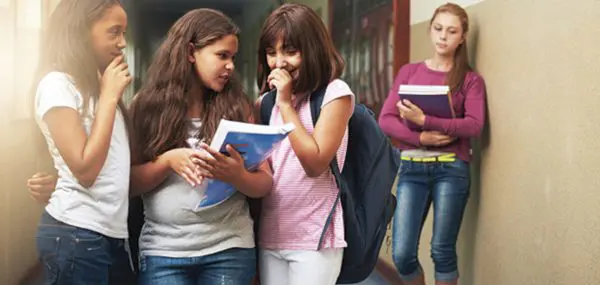I sit behind two girls in first period. Their Victoria Secret perfume fills the air around them. They are dressed in the same hot pink, low-cut shirt and tight yoga pants. They have the same walk – a mix of a strut and a shuffle – and talk in the same high-pitched voice. The two girls are clones of each other.
I hear them laugh, so I look up. A boy with stained, baggy clothes walks into the room. The pile of books starts to slip out of his sweaty hands. The two girls whisper, point and laugh as the books fall from his hands. He scrambles to pick them up. I know without looking at him that he is hurt and embarrassed. He tries not to show it. The girls’ attention moves to a girl who just walked in with a new haircut, and as they walk over to her, she prepares herself for their mean remarks. All this happens in the few minutes that the teacher’s back is turned.
Bullying Experiences You Don’t Always See
Third period: I pass the girl with the new haircut in the hallway. I don’t think it looks bad. Honestly, I like it. I see her with her friends, and they seem to like her haircut too. But that doesn’t matter. I bet she is still thinking about the girls from first period.
I get on the bus with my friends. The boy from first period gets on the bus and clumsily walks down the aisle, lugging his instrument case and cluttered, half-opened backpack behind him. He looks for a seat away from everyone in our grade, but the farthest open seat is diagonal from mine. He throws his things onto the seat and puts on his headphones. Like the girl with the new haircut, he is also probably thinking about the girls from first period, and he doesn’t want to get harassed by the kids on the bus either.
Though schools have bumped up their bully radar, both of these kids were made fun of without teachers seeing it happen. If adults don’t notice or recognize bullying experiences when they occur, they can’t be fixed. Things that may seem small to them really hurt in a teenager’s eyes.
Teen Bullying Statistics
Here are some bullying statistics that may shock you:
- 160,000 students stay home because they’re afraid of being bullied
- 80% of the time, an argument with a bully will end up in a physical fight
- Every 7 minutes, a child is bullied.
- Adult intervention: 4%
- Peer intervention: 11%
- No intervention: 85%
- 97% of middle schoolers are bullied while online
- 58% of kids admit someone has said mean or hurtful things to them online. More than 4 out of 10 say it has happened more than once.
- 58% of kids have not told an adult about something mean or hurtful that happened to them online.
Teenagers see things differently than adults; it is a fact. Usually it is harder to read emotions on teenagers, which is why adults should frequently ask about and address bullying experiences. Do not to let any hurt feeling sneak by unnoticed. Who knows, maybe someone needs you to step in.




